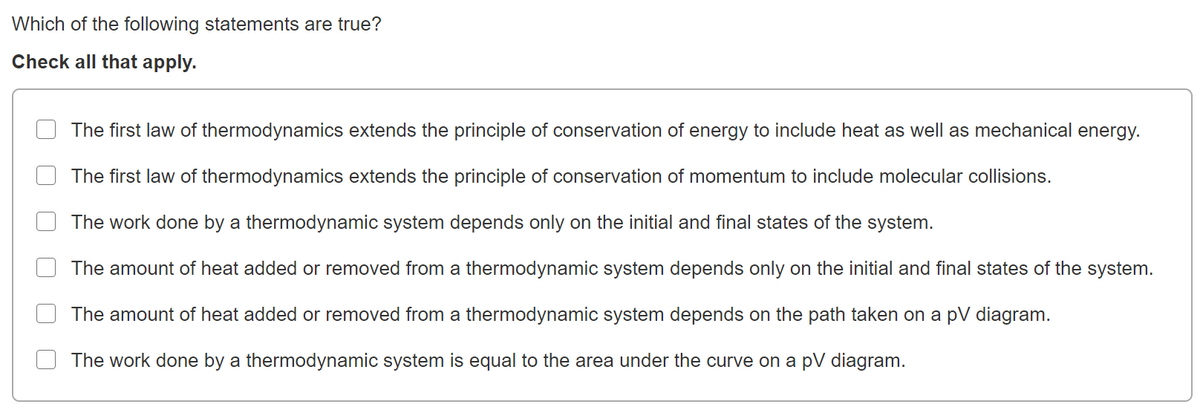The first law of thermodynamics extends the principle of conservation of energy to include heat as well as mechanical energy. O The first law of thermodynamics extends the principle of conservation of momentum to include molecular collisions. The work done by a thermodynamic system depends only on the initial and final states of the system. The amount of heat added or removed from a thermodynamic system depends only on the initial and final states of the system. The amount of heat added or removed from a thermodynamic system depends on the path taken on a pV diagram. The work done by a thermodynamic system is equal to the area under the curve on a pV diagram.
The first law of thermodynamics extends the principle of conservation of energy to include heat as well as mechanical energy. O The first law of thermodynamics extends the principle of conservation of momentum to include molecular collisions. The work done by a thermodynamic system depends only on the initial and final states of the system. The amount of heat added or removed from a thermodynamic system depends only on the initial and final states of the system. The amount of heat added or removed from a thermodynamic system depends on the path taken on a pV diagram. The work done by a thermodynamic system is equal to the area under the curve on a pV diagram.
Principles of Physics: A Calculus-Based Text
5th Edition
ISBN:9781133104261
Author:Raymond A. Serway, John W. Jewett
Publisher:Raymond A. Serway, John W. Jewett
Chapter18: Heat Engines, Entropy, And The Second Law Of Thermodynamics
Section: Chapter Questions
Problem 6OQ
Related questions
Question
See attached

Transcribed Image Text:Which of the following statements are true?
Check all that apply.
The first law of thermodynamics extends the principle of conservation of energy to include heat as well as mechanical energy.
The first law of thermodynamics extends the principle of conservation of momentum to include molecular collisions.
The work done by a thermodynamic system depends only on the initial and final states of the system.
The amount of heat added or removed from a thermodynamic system depends only on the initial and final states of the system.
The amount of heat added or removed from a thermodynamic system depends on the path taken on a pV diagram.
The work done by a thermodynamic system is equal to the area under the curve on a pV diagram.
Expert Solution
This question has been solved!
Explore an expertly crafted, step-by-step solution for a thorough understanding of key concepts.
This is a popular solution!
Trending now
This is a popular solution!
Step by step
Solved in 2 steps

Knowledge Booster
Learn more about
Need a deep-dive on the concept behind this application? Look no further. Learn more about this topic, physics and related others by exploring similar questions and additional content below.Recommended textbooks for you

Principles of Physics: A Calculus-Based Text
Physics
ISBN:
9781133104261
Author:
Raymond A. Serway, John W. Jewett
Publisher:
Cengage Learning

Physics for Scientists and Engineers, Technology …
Physics
ISBN:
9781305116399
Author:
Raymond A. Serway, John W. Jewett
Publisher:
Cengage Learning

Physics for Scientists and Engineers: Foundations…
Physics
ISBN:
9781133939146
Author:
Katz, Debora M.
Publisher:
Cengage Learning

Principles of Physics: A Calculus-Based Text
Physics
ISBN:
9781133104261
Author:
Raymond A. Serway, John W. Jewett
Publisher:
Cengage Learning

Physics for Scientists and Engineers, Technology …
Physics
ISBN:
9781305116399
Author:
Raymond A. Serway, John W. Jewett
Publisher:
Cengage Learning

Physics for Scientists and Engineers: Foundations…
Physics
ISBN:
9781133939146
Author:
Katz, Debora M.
Publisher:
Cengage Learning

College Physics
Physics
ISBN:
9781938168000
Author:
Paul Peter Urone, Roger Hinrichs
Publisher:
OpenStax College

College Physics
Physics
ISBN:
9781305952300
Author:
Raymond A. Serway, Chris Vuille
Publisher:
Cengage Learning

College Physics
Physics
ISBN:
9781285737027
Author:
Raymond A. Serway, Chris Vuille
Publisher:
Cengage Learning